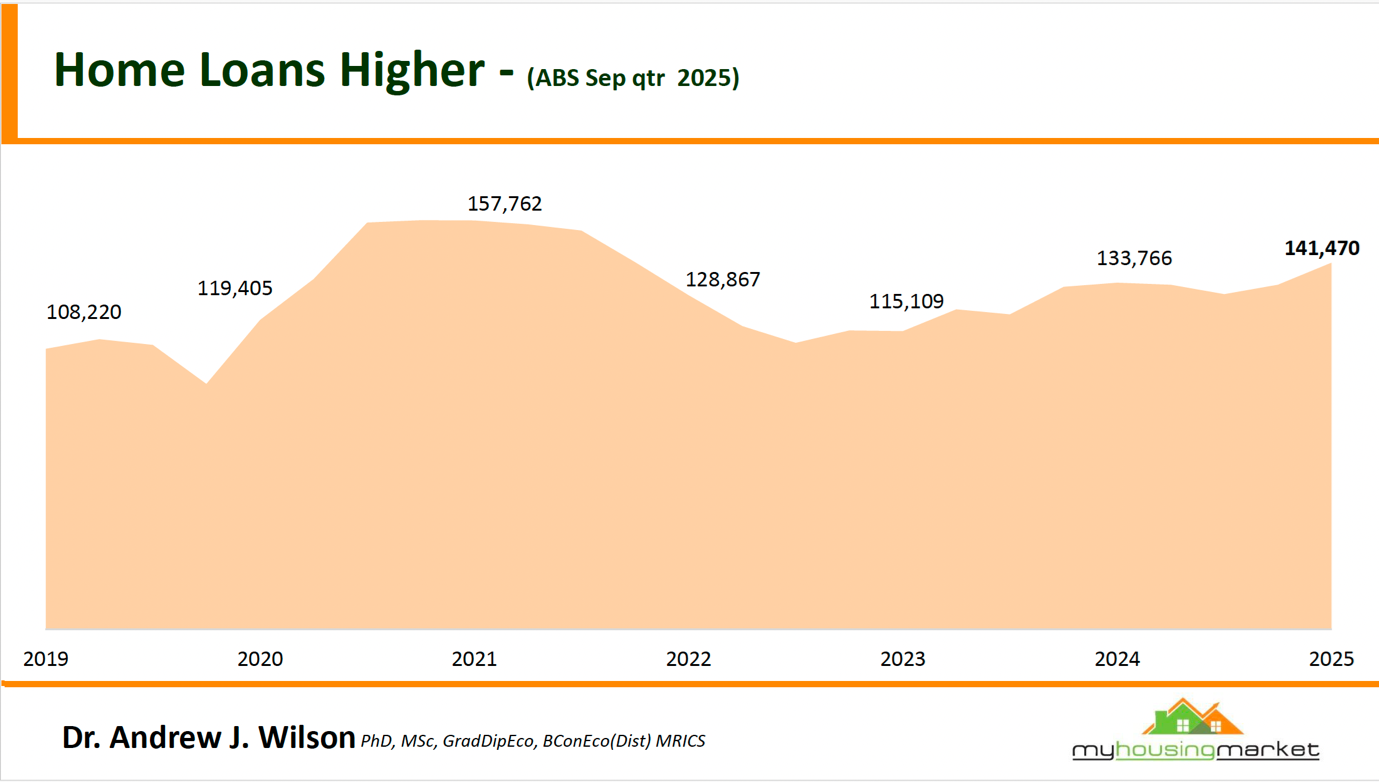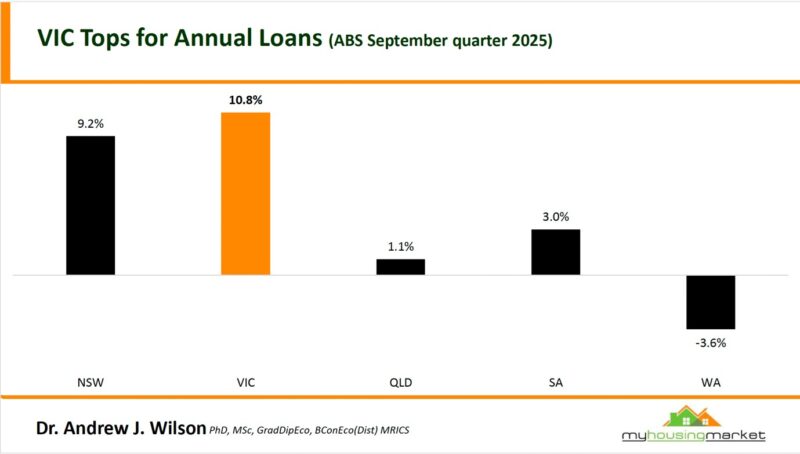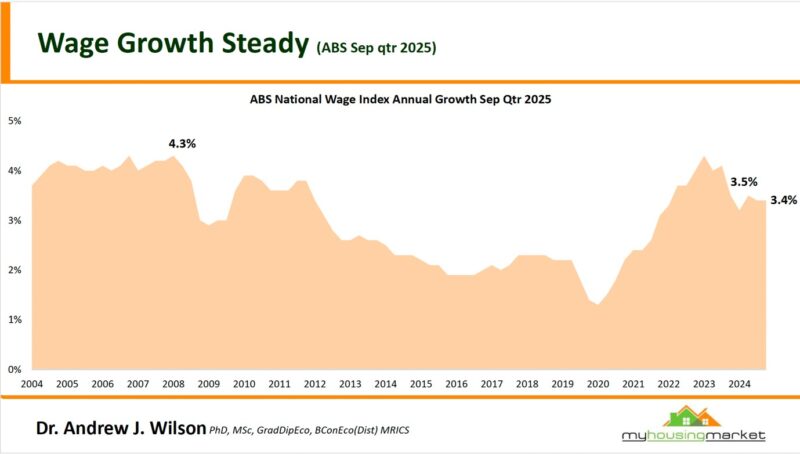
Key takeaways
The lending data shows a clear shift: investors are leading the market’s next upswing, with a 6% quarterly jump in investor loans—well ahead of all other buyer segments.
Lending is a leading indicator, so this points to stronger price growth ahead, especially as first-home buyers are now also returning in greater numbers.
Construction costs have turned upward, driven by labour shortages, capacity constraints, and supply chain issues.
Rising replacement costs support established property values and further delay new housing supply. With Australia already short of dwellings, rising costs cement the structural undersupply story.
Wages rose 0.8% over the quarter and 3.4% annually, showing no wage breakout and easing inflation concerns. But it also means households aren't suddenly cashed-up.
The current market strength isn’t being driven by income growth—it’s being driven by undersupply and population growth.
Clearance rates have eased slightly as spring listings increase, but the market is still remarkably resilient.
Even with more choice and more selective buyers, competition remains solid—another sign that underlying demand outweighs supply.
Every week the headlines tell you one thing… but the data often tells you something very different.
This week’s numbers painted a picture that many property investors will find both reassuring and strategically important.
Beneath the noise, there are clear signs of Australia’s housing market entering its next phase – one driven by rising construction costs, steady wage growth, strengthening lending activity, and auction markets that are cooling slightly but remain remarkably resilient.
And as always, the mainstream commentary only scratches the surface.
In this week's Property Insider chat, Dr. Andrew Wilson and I look at the surprising jump in investor lending, what’s driving building costs higher again, why wage growth is flattening, and what the auction markets are really telling us.
Most importantly, we’ll show you how these pieces fit together so you can anticipate what’s likely to happen next.
Home lending is surging – and investors are leading the charge
Watch this week's Property Insider chat as Dr. Andrew Wilson explains what's happening to lending, which is a leading indicator of future housing market movement.

Over the September quarter:
- Total home loans rose 4 percent
- Owner-occupier loans increased 2 percent
- First home buyers rose 3 percent
- Investor loans surged 6 percent – far outpacing every other buyer group
- Year-on-year, total lending is up 8 percent
Investors aren’t just back… They’re back in force.

In my mind, many investors recognise opportunity when they see it.
This data is a little backward-looking, and it's likely the next quarter’s figures will show even more first-home buyers because, as we know, they are now out in force again.
The geographic breakdown was also compelling:
- NSW led quarterly home lending volumes
- Victoria topped annual lending growth
- QLD, SA, and WA showed softer but still solid trends
This is exactly what you’d expect in a market where population growth remains strong and supply is stalled.

Building costs are rising again – and that has big implications
Watch this week's Property Insider chat as Dr. Andrew Wilson explains how building costs have turned upward again.

Dr Wilson’s National House Building Cost Index shows growth has lifted through September, reversing the moderation we saw earlier in the year. That’s significant for two reasons:
- It pushes up replacement costs, which supports higher established dwelling prices.
- It delays and discourages new supply, worsening the structural shortage already gripping the country.
The annual growth rate chart in the report highlights that after easing through 2023, cost pressures have re-emerged in 2024–25. This reflects higher labour costs, tradie shortages, tight construction capacity, and ongoing supply chain constraints.
For investors, this is a reminder that housing supply simply cannot scale quickly enough to meet demand – and this will continue to be a major driver of capital growth.

Wage growth is steady – but not surging
The ABS Wage Index rose 0.8 per cent over the September quarter, identical to the June quarter, with annual wages growth sitting at 3.4 per cent.
In other words, no wage breakout and no signal that households are suddenly flush with extra disposable income.
This is exactly the kind of data the RBA wants to see. It suggests inflationary pressure from wages is contained – but it also tells us that many borrowers are still navigating a tight financial environment.

This means don’t expect wages to drive a demand boom – that’s not what’s pushing the market today.
Auction markets are easing – but still remarkably strong
Australia’s auction markets remained robust last week, with clearance rates drifting lower as we head toward the end of the spring selling season.
Yet even with listings elevated and buyers more selective, the numbers remain healthy:

So What Does All This Mean?
When you step back and connect the dots, a clearer narrative emerges:
- Building costs are rising, restricting future supply.
- Wage growth is steady, reducing inflation pressure.
- Investor lending is accelerating, signalling confidence.
- Auction markets remain resilient, even as they ease seasonally.
Put simply: This is a market with solid underlying fundamentals and significant forward pressure on prices.
And as Dr Andrew Wilson and I discuss, the next phase of the cycle is likely to be driven by a combination of undersupply, population growth, returning investor demand, and a resurgence of first-home buyers – not by interest rates.














